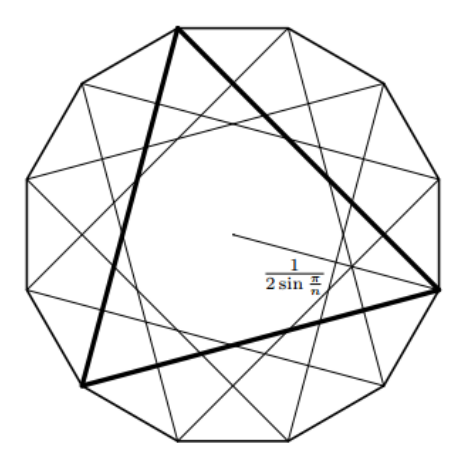题目大意
有一个边长为 (1) 的正 (n) 边形,你要把这个正 (n) 边形放到一个正 (m) 边形里面,且两个多边形的中心重合。
问你这个正 (m) 边形的边长最小是多少。
(n,mleq {10}^9)
题解
对于一种合法的方案,把这个正 (n) 边形旋转 (frac{2pi}{m}) 度之后也能放到这个正 (m) 边形里面。
那么把所有 (frac{m}{gcd(n,m)}) 种多边形拼到一起之后就会得到一个 (operatorname{lcm}(n,m)) 边形。
现在我们要把正 (operatorname{lcm}(n,m)) 边形塞进一个正 (m) 边形。
这就很简单了。
这个正 (m) 边形的每条边对准这个正 (operatorname{lcm}(n,m)) 边形就好了。


代码
#include<cstdio>
#include<cstring>
#include<algorithm>
#include<cstdlib>
#include<ctime>
#include<utility>
#include<functional>
#include<cmath>
#include<vector>
//using namespace std;
using std::min;
using std::max;
using std::swap;
using std::sort;
using std::reverse;
using std::random_shuffle;
using std::lower_bound;
using std::upper_bound;
using std::unique;
using std::vector;
typedef long long ll;
typedef unsigned long long ull;
typedef double db;
typedef std::pair<int,int> pii;
typedef std::pair<ll,ll> pll;
void open(const char *s){
#ifndef ONLINE_JUDGE
char str[100];sprintf(str,"%s.in",s);freopen(str,"r",stdin);sprintf(str,"%s.out",s);freopen(str,"w",stdout);
#endif
}
void open2(const char *s){
#ifdef DEBUG
char str[100];sprintf(str,"%s.in",s);freopen(str,"r",stdin);sprintf(str,"%s.out",s);freopen(str,"w",stdout);
#endif
}
int rd(){int s=0,c,b=0;while(((c=getchar())<'0'||c>'9')&&c!='-');if(c=='-'){c=getchar();b=1;}do{s=s*10+c-'0';}while((c=getchar())>='0'&&c<='9');return b?-s:s;}
void put(int x){if(!x){putchar('0');return;}static int c[20];int t=0;while(x){c[++t]=x%10;x/=10;}while(t)putchar(c[t--]+'0');}
int upmin(int &a,int b){if(b<a){a=b;return 1;}return 0;}
int upmax(int &a,int b){if(b>a){a=b;return 1;}return 0;}
const db pi=acos(-1);
ll gcd(ll a,ll b)
{
return b?gcd(b,a%b):a;
}
ll n,m;
int main()
{
open("b");
scanf("%lld%lld",&n,&m);
db r=1./2/sin(pi/n);
n=n/gcd(n,m)*m;
r*=cos(pi/n);
db ans=r*tan(pi/m)*2;
printf("%.10f
",ans);
return 0;
}